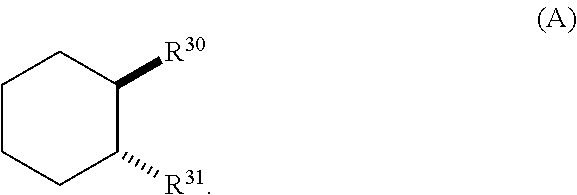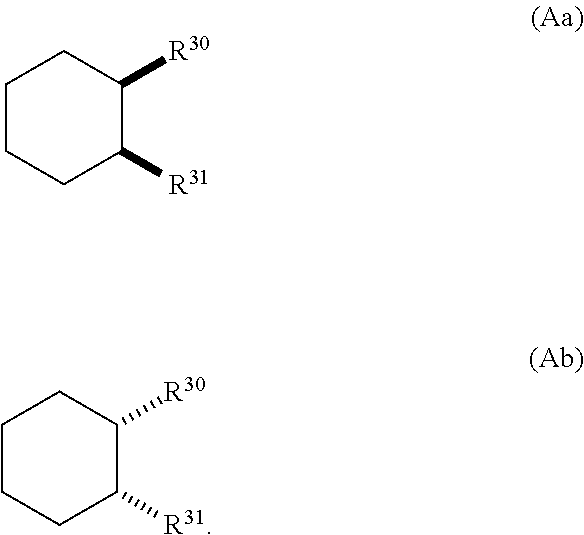Benzenesulfonamide compounds and their use as therapeutic agents
a technology of benzenesulfonamide and compound, which is applied in the field of benzenesulfonamide compounds, can solve the problems of affecting the effect of drug therapy, so as to increase the potency of existing or future drug therapy and reduce the adverse events
- Summary
- Abstract
- Description
- Claims
- Application Information
AI Technical Summary
Benefits of technology
Problems solved by technology
Method used
Image
Examples
example 1
Synthesis of 3-chloro-4-((3,3-dimethylpiperidin-4-yl)oxy)-N-(1,2,4-thiadiazol-5-yl)benzenesulfonamide 2,2,2-trifluoroacetate
[0839]
Step 1. Preparation of 3-chloro-N-(2,4-dimethoxybenzyl)-4-fluoro-N-(1,2,4-thiadiazol-5-yl)benzenesulfonamide
[0840]
[0841]To a mixture of N-(2,4-dimethoxybenzyl)-1,2,4-thiadiazol-5-amine (prepared according to PCT Published Patent Application No. WO 2010 / 079443, 15.1 g, 60.2 mmol) in anhydrous tetrahydrofuran (200 mL) was added a 1 M solution of lithium bis(trimethylsilyl)amide in tetrahydrofuran (72.1 mL, 72.1 mmol) at 0° C. and the reaction mixture was stirred for 1 h at ambient temperature. The reaction mixture was cooled to −78° C. and a solution of 3-chloro-4-fluorobenzenesulfonyl chloride (13.8 g, 60.2 mmol) in anhydrous tetrahydrofuran (40 mL)) was added to it. The reaction mixture was allowed to warm to ambient temperature, stirred for 2 h, and diluted with ethyl acetate (280 mL). The mixture was washed with saturated ammonium chloride solution (2×1...
example 2
Synthesis of 4-((1-benzyl-3,3-dimethylpiperidin-4-yl)oxy)-3-chloro-N-(1,2,4-thiadiazol-5-yl)benzenesulfonamide 2,2,2-trifluoroacetate
[0848]
[0849]To a mixture of 3-chloro-4-((3,3-dimethylpiperidin-4-yl)oxy)-N-(1,2,4-thiadiazol-5-yl)benzenesulfonamide 2,2,2-trifluoroacetate (0.20 g, 0.39 mmol) and benzaldehyde (0.08 g, 0.78 mmol) in anhydrous 1,2-dichloroethane (8 mL) was added sodium triacetoxyborohydride (0.17 g, 0.78 mmol) and the resulting mixture was stirred for 18 h. The mixture was diluted with ethyl acetate (50 mL), washed with saturated ammonium chloride (2×30 mL), and the organic phase was concentrated in vacuo. The residue was purified by preparative reverse-phase HPLC eluting with a gradient of 10 to 60% of acetonitrile in water containing 0.1% of trifluoroacetic acid to provide the title compound as a colorless solid (0.075 g, 32% yield): 1H NMR (300 MHz, DMSO-d6) δ 9.71 (br s, 1H), 8.43 (s, 1H), 7.75-7.70 (m, 1H), 7.68 (dd, J=8.7, 2.3 Hz, 1H), 7.56-7.32 (m, 6H), 4.55-4.4...
example 3
Synthesis of 3-chloro-4-((1-(3,5-dimethylbenzyl)-3,3-dimethylpiperidin-4-yl)oxy)-N-(1,2,4-thiadiazol-5-yl)benzenesulfonamide 2,2,2-trifluoroacetate
[0850]
[0851]Following the procedure as described for EXAMPLE 2 and making non-critical variations as required to replace benzaldehyde with 3,5-dimethylbenzaldehyde, the title compound was obtained as a colorless solid (0.17 g, 67% yield): 1H NMR (300 MHz, DMSO-d6) δ 9.51 (br s, 1H), 8.43 (s, 1H), 7.74 (d, J=2.1 Hz, 1H), 7.68 (dd, J=8.7, 2.1 Hz, 1H), 7.42-7.33 (m, 1H), 7.16-7.03 (m, 3H), 4.58-4.40 (m, 1H), 4.29-4.13 (m, 2H), 3.45-3.02 (m, 3H), 2.99-2.78 (m, 1H), 2.26 (s, 6H), 2.19-2.05 (m, 1H), 2.01-1.75 (m, 1H), 1.16 (d, J=13.1 Hz, 3H), 0.93 (s, 3H) (Note: NH not observed); MS (ES+) m / z 521.0 (M+1), 523.0 (M+1).
PUM
| Property | Measurement | Unit |
|---|---|---|
| voltage-gated | aaaaa | aaaaa |
Abstract
Description
Claims
Application Information
 Login to View More
Login to View More - R&D
- Intellectual Property
- Life Sciences
- Materials
- Tech Scout
- Unparalleled Data Quality
- Higher Quality Content
- 60% Fewer Hallucinations
Browse by: Latest US Patents, China's latest patents, Technical Efficacy Thesaurus, Application Domain, Technology Topic, Popular Technical Reports.
© 2025 PatSnap. All rights reserved.Legal|Privacy policy|Modern Slavery Act Transparency Statement|Sitemap|About US| Contact US: help@patsnap.com



